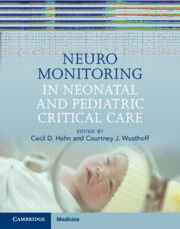Book contents
- Neuromonitoring in Neonatal and Pediatric Critical Care
- Reviews
- Neuromonitoring in Neonatal and Pediatric Critical Care
- Copyright page
- Contents
- Contributors
- Acknowledgements
- Part I General Considerations in Neuromonitoring
- Chapter 1 Overview of Continuous EEG Monitoring in Critically Ill Neonates and Children
- Chapter 2 Technical Aspects of Neurophysiological Monitoring
- Chapter 3 Logistics of Neuromonitoring
- Chapter 4 Nursing Considerations in Neuromonitoring
- Chapter 5 Normal Neurophysiology, Benign Findings, and Artifacts
- Chapter 6 Abnormal EEG in the Intensive Care Unit
- Part II Practice of Neuromonitoring: Neonatal Intensive Care Unit
- Part III Practice of Neuromonitoring: Pediatric Intensive Care Unit
- Part IV Practice of Neuromonitoring: Cardiac Intensive Care Unit
- Part V Cases
- Index
- References
Chapter 4 - Nursing Considerations in Neuromonitoring
from Part I - General Considerations in Neuromonitoring
Published online by Cambridge University Press: 08 September 2022
- Neuromonitoring in Neonatal and Pediatric Critical Care
- Reviews
- Neuromonitoring in Neonatal and Pediatric Critical Care
- Copyright page
- Contents
- Contributors
- Acknowledgements
- Part I General Considerations in Neuromonitoring
- Chapter 1 Overview of Continuous EEG Monitoring in Critically Ill Neonates and Children
- Chapter 2 Technical Aspects of Neurophysiological Monitoring
- Chapter 3 Logistics of Neuromonitoring
- Chapter 4 Nursing Considerations in Neuromonitoring
- Chapter 5 Normal Neurophysiology, Benign Findings, and Artifacts
- Chapter 6 Abnormal EEG in the Intensive Care Unit
- Part II Practice of Neuromonitoring: Neonatal Intensive Care Unit
- Part III Practice of Neuromonitoring: Pediatric Intensive Care Unit
- Part IV Practice of Neuromonitoring: Cardiac Intensive Care Unit
- Part V Cases
- Index
- References
Summary
Neuromonitoring is a shared responsibility in the ICU with several key roles for bedside nursing staff, including the identification and reporting of trends. Nursing staff should be familiar with equipment and supplies needed for neuromonitoring as well as troubleshooting common artifacts and problems. Guideline development and ongoing education are essential to the success of any neuromonitoring program. This chapter provides suggested pathways for integrating bedside neuromonitoring into clinical practice and discussion of day-to-day nursing roles and responsibilities related to bedside monitoring. Multiple modalities, including EEG, aEEG, QEEG, and NIRS, are discussed.
Keywords
- Type
- Chapter
- Information
- Neuromonitoring in Neonatal and Pediatric Critical Care , pp. 35 - 47Publisher: Cambridge University PressPrint publication year: 2022

